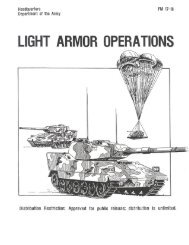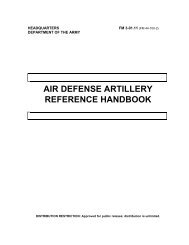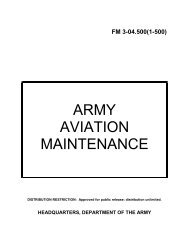fm 44-100 us army air and missile defense operations
fm 44-100 us army air and missile defense operations
fm 44-100 us army air and missile defense operations
You also want an ePaper? Increase the reach of your titles
YUMPU automatically turns print PDFs into web optimized ePapers that Google loves.
FM <strong>44</strong>-<strong>100</strong><br />
1-2<br />
<strong>missile</strong>s, <strong>and</strong> unmanned aerial vehicles from locating, striking, <strong>and</strong><br />
destroying them.<br />
AIR DEFENSE ARTILLERY MISSION<br />
1-6. The mission of US Army Air Defense Artillery is to protect the force <strong>and</strong><br />
selected geopolitical assets from aerial attack, <strong>missile</strong> attack, <strong>and</strong><br />
surveillance.<br />
FORCES<br />
1-7. ADA comm<strong>and</strong>ers allocate forces based on the supported comm<strong>and</strong>er's<br />
priorities. In addition, the mission is broadly written to include protection of<br />
critical assets, installations, <strong>and</strong> facilities along with joint <strong>and</strong> multinational<br />
forces when required.<br />
GEOPOLITICAL ASSETS<br />
1-8. Geopolitical assets are nonmilitary assets that US, allied, or host nation<br />
civil authorities nominate for <strong>air</strong> <strong>and</strong> <strong>missile</strong> <strong>defense</strong> protection. These assets<br />
could be political, religio<strong>us</strong>, ethnic, historical, or territorial in nature. Since<br />
protection of geopolitical assets may not directly support military <strong>operations</strong>,<br />
integration of geopolitical assets into the <strong>air</strong> <strong>and</strong> <strong>missile</strong> <strong>defense</strong> priorities<br />
list m<strong>us</strong>t be done at the highest levels. Geopolitical assets may include the<br />
territory of the USA.<br />
THREAT<br />
1-9. The threat is not limited to attack <strong>air</strong>craft, helicopters, <strong>and</strong> ballistic<br />
<strong>missile</strong>s. The threat includes all <strong>air</strong>craft, indirect fire surface-launched<br />
<strong>missile</strong>s, aerial surveillance platforms, large caliber rockets, <strong>and</strong> theater<br />
<strong>missile</strong>s. Chapter 2 provides more detail <strong>and</strong> information on the threat.<br />
CONSEQUENCES<br />
1-10. Successful <strong>air</strong> <strong>and</strong> <strong>missile</strong> <strong>defense</strong> is key to generating <strong>and</strong> s<strong>us</strong>taining<br />
combat power in force-projection <strong>operations</strong>. The ADA contribution to<br />
friendly efforts to counter threat reconnaissance, intelligence surveillance,<br />
<strong>and</strong> target acquisition efforts has gained greater emphasis. Current <strong>and</strong><br />
future Army ADA capabilities, both active <strong>and</strong> reserve component, m<strong>us</strong>t<br />
synergistically combine with the AMD forces of other services to defeat the<br />
multifaceted threat. Army ADA participates in <strong>operations</strong> at all levels of war.<br />
NATIONAL MISSILE DEFENSE OPERATIONS<br />
1-11. National Missile Defense is a joint service program to develop a fixed,<br />
l<strong>and</strong>-based system to protect the United States against limited, long-range<br />
ballistic <strong>missile</strong> attacks. The US Army Space <strong>and</strong> Missile Defense Comm<strong>and</strong><br />
(USASMDC) has responsibility for publishing National Missile Defense<br />
(NMD) doctrine.











